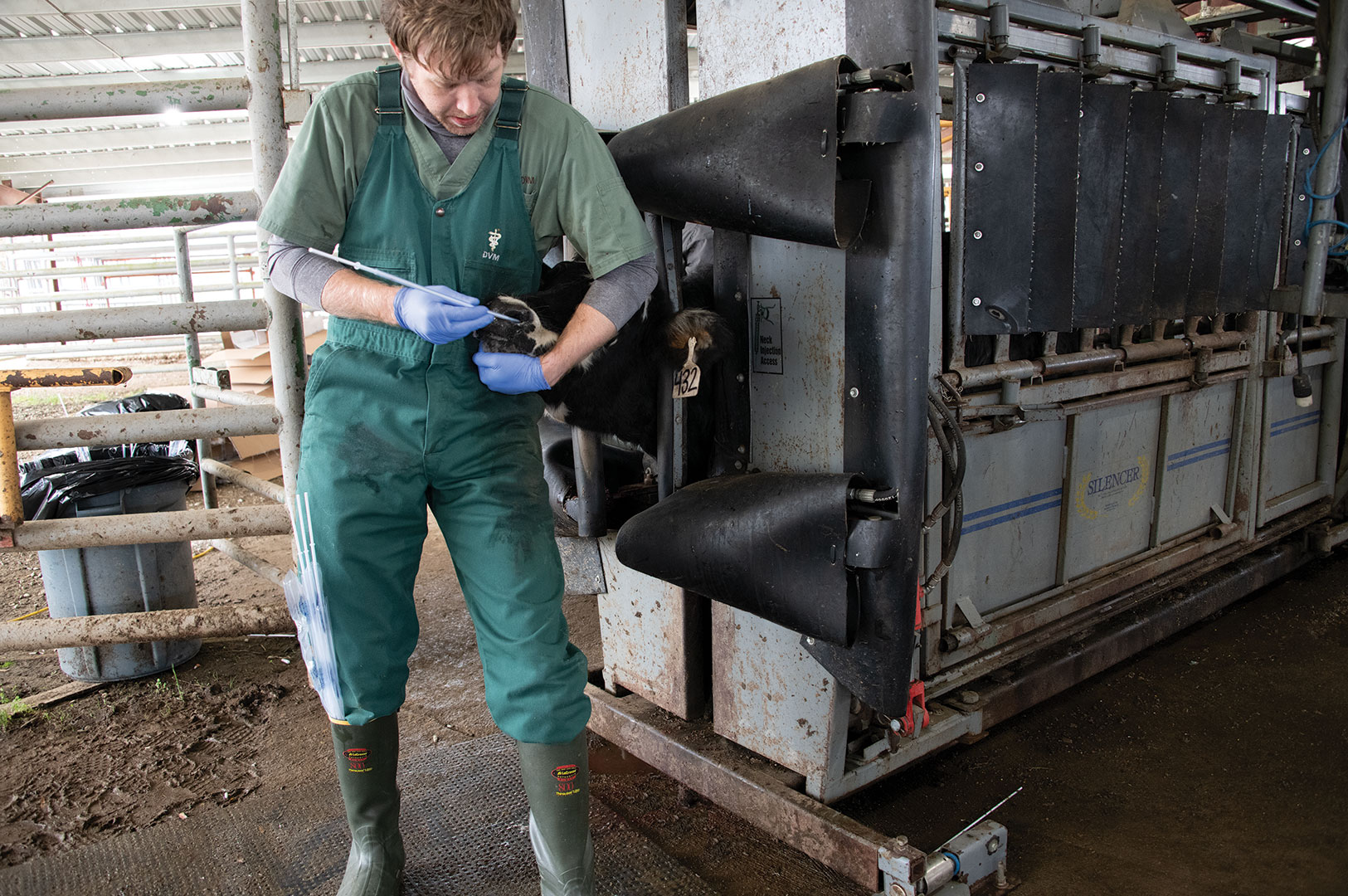According to the Journal of Animal Science, bovine respiratory disease, or BRD, is the most significant disease impacting the American feedlot industry, costing approximately $800-$900 million annually. Considered a multifactorial disease, diagnosis can be tricky. That's why MAFES scientists are using Near Infrared Spectroscopy or NIRS to find a better way to diagnose BRD.
Dr. Florencia Meyer, associate professor, and Dr. Carrie Vance, associate research professor, both in the Department of Biochemistry, Molecular Biology, Entomology and Plant Pathology, have teamed up with Dr. Amelia Woolums, professor in the Department of Pathobiology and Population Medicine in the College of Veterinary Medicine, to find a better, easier, and faster way to diagnose BRD.
Multiple factors contribute to BRD including bacteria such as Mannheimia haemolytica and viruses like the bovine herpes virus. How those pathogens interact with the animal's immune system also impact the level of illness in the animal. Additionally, animal characteristics like the animal's age or immune status and environmental factors including transport, crowding, and temperature fluctuations also play a role.
"Environmental stressors like weather or transport or a bacteria or virus can initiate a BRD infection when the animal's immune system is suppressed, which then makes the animal prone to a secondary bacterial infection," Meyer said. "Once the respiratory bacteria gains entrance to the lower part of the respiratory tract and gets into the lungs, it can cause pneumonia, high fever, difficulty breathing, and a host of other issues. BRD can result in mortality and morbidity so it's a big economic problem not only in Mississippi but globally."
Meyer said the project's purpose is to develop a diagnostic strategy for the early detection and treatment of animals developing BRD, contributing to the sustainability and competitiveness of the U.S. beef supply.
"For this application, the overall objective is to develop a means to analyze a global set of health parameters in a rapid, nondestructive assay that can determine the specific health status of animals at risk of developing BRD," Meyer explained.
Meyer, whose work has centered around BRD for the past several years, said such a test would be a welcomed change to the industry.
"A test like this would be a game changer because the current visual clinical diagnosis of BRD isn't that effective. If the animal is experiencing a fever or nasal discharge, they are treated for BRD whether they have it or not. In the future, bringing a small NIRS device into the field to test quickly and accurately for BRD would let producers know which cattle need to be treated right way. Since most producers treat all cattle for BRD regardless of symptoms, such a tool would also curb the unnecessary use of antibiotics, which can lead to the appearance of antibiotic-resistance pathogens," Meyer explained.
Vance, an NIRS expert who used the technology most predominantly in aiding reproduction of threatened wildlife species, is excited to apply it in a novel way for the cattle industry.
"Our hope is to use modeling and spectroscopy to decipher bovine respiratory disease presence and quantity in cattle," Vance said. "If we can model what the disease profile looks like, it's more like a fingerprint than a single assay."
Vance explained that while most diseases are analyzed with a single assay or test, this research uses light, water, and chemistry to measure the biochemical differences brought on by the disease.
"In this case, we're identifying a suite of signals that arise from the infection because we aren't looking to detect the pathogen itself but the influence of the pathogen in the animal's response," she said. "This is a biochemical fingerprint for an animal's physiological state."
The team hopes the assay can use a simple sample of saliva, nasal secretion, breath condensate, or even blood to rapidly assess the animal's diseased state. They have collected these fluids from a small sampling of animals and are analyzing the samples and thus far, have had some positive results. Next steps include a larger sampling of animals and eventually a feedlot trial to demonstrate efficacy in an industrial setting.
"This is a more holistic approach in the sense that we're evaluating how the whole body is responding to the onset of the disease," Vance said.
She pointed out such a test would be exponentially better than the current way BRD is diagnosed in the field setting, using visual clinical diagnosis.
"The estimated sensitivity of a traditional visual clinical diagnosis is only 62 percent, which means that 38 percent of cattle with BRD go unidentified and untreated. Meanwhile, with only a 63 percent specificity rate, uninfected cattle constitute 37 percent of all cattle treated for BRD," Vance explained. "Our current model prediction, just in the preliminary study, had an overall accuracy of 83.3 percent, with a sensitivity of 79.2 percent, and a specificity of 87.5 percent, which is much higher than a current BRD diagnosis."
Vance said the promising results should eventually lead to better diagnostic tools for BRD.
"The industry needs a better way to delineate which animals are truly sick, whether they're showing symptoms or not. You can separate out those that are sick and treat them properly. The sooner you can do that, the more you can control transmission and prevent infection that might otherwise be left to spread throughout the herd," she said.
In addition to Woolums, collaborators include Mariana Santos-Rivera, Merrilee Thoresen, Ellianna Blair, and Victoria Jefferson. The work was funded by the Mississippi Agricultural and Forestry Experiment Station's Special Research Initiative and the USDA-ARS 58-6402-018 Biophotonics Initiative.
Our hope is to use modeling and spectroscopy to decipher bovine respiratory disease presence and quantity in cattle. If we can model what the disease profile looks like, it's more like a fingerprint than a single assay.
Dr. Carrie Vance
Behind the Science

Florencia Meyer
Associate Professor
Education: B.S., Biochemistry, Universidad de la Republica, Uruguay; M.S., Biological Sciences/Microbiology, Texas Tech University; Ph.D., Molecular Virology, University of Nebraska
Years At MSU: 11
Focus: Virus-host interactions, microbial co-infections, bovine respiratory disease
Passion At Work: My goal is to understand the biology of viral and bacterial infections to diagnose, treat, or prevent disease. The knowledge gained can then be applied to other microbe-host systems.

Carrie Vance
Associate Research Professor
Education: B.S., Chemistry and Mathematics; Ohio State University; M.S., Physical Chemistry, California Institute of Technology; Ph.D., Biophysics and Biochemistry, Johns Hopkins University
Years At MSU: 6
Focus: Biophotonics; applications of spectroscopic and other photonic techniques to living systems
Passion At Work: I like to see students get excited about science, especially when they explore outside the classroom and get involved in a research project that they can then publish and present. It 's really a whole new world for them.


